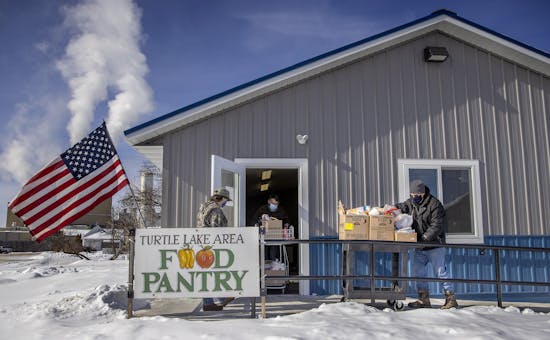Carl Klienschmidt braced for a rush of residents in need of help at his western Wisconsin food pantry. But surprisingly, the opposite happened.
In the tiny town of Turtle Lake, the volunteer-run pantry is serving fewer people than pre-pandemic, bucking the national trend of growing hunger. Across the border in Minnesota, Christi Dickey is also still waiting for the surge in need she and other volunteers expected at Fergus Falls' food shelf.
"We've been scratching our heads just wondering what's going on," she said.
It's a puzzling paradox at a time when Minnesota and Wisconsin are recording rising statewide hunger. In Minnesota, the state's 350 food shelves saw a record 3.8 million visits statewide in 2020 — more than any other year — and several Twin Cities nonprofits are dishing up free meals or groceries to double or triple the number of people as pre-pandemic.
Meanwhile, some rural counties tallied double-digit percentage drops at food shelves. In Wisconsin, an analysis of 14 rural counties near the Minnesota border found a 5% drop in visits to food pantries in 2020, according to the Wisconsin Department of Human Services.
But hunger isn't fading in rural regions. Instead, rural residents in need could be less reliant on food shelves during the pandemic, leaning on a growing number of informal pop-up food distributions as well as federal aid in stimulus checks, bolstered unemployment assistance and extra money in food stamps.
"It was really this huge holistic support across the board," said Joe Walker of Hunger Solutions Minnesota. "It alleviated some of the pressure off the shelves and also bought them time to make the necessary adjustments."
Rise in use of food stamps
In Wisconsin, the number of people on food stamps went up 22% from last March to December. Rural counties saw the largest increases in rates of food stamp applications, according to the Hunger Relief Federation of Wisconsin.
In Minnesota, the number of residents receiving food stamps, also called the Supplemental Nutrition Assistance Program (SNAP), spiked 11% in 2020. That was evident in many rural counties where food shelf use dwindled. For instance, while Otter Tail County counted a 32% drop in food shelf visitors, the county had a 17% increase in people receiving SNAP.
The hunger relief system also has more food than ever before, leading programs to give out more food per person than pre-pandemic, which may mean residents are returning less often, also skewing data. Feeding Wisconsin's six food banks distributed 50-80% more pounds of food in 2020. Second Harvest Heartland, the largest of seven food banks in Minnesota, delivered 21% more pounds of food in 2020 in Minnesota and western Wisconsin.
"We refer to it as a tsunami of food," said Sherrie Tussler, executive director of the Milwaukee-based Hunger Task Force. "Good things have come out of [the pandemic]."
In 2020, the U.S. Department of Agriculture started the "Farmers to Families" food boxes, buying and distributing produce, dairy and meat from farmers to food banks, schools and other organizations. Some of those boxes ended up at new food pop-ups that emerged at neighborhoods and churches due to the pandemic.
In Hinckley, 500 cars filled a community center parking lot each month for those food boxes last summer and fall. No questions were asked, unlike at federally funded food shelves.
"People are a little more comfortable with that," said Kathy Wills of Family Pathways, which operates nine food shelves in Minnesota and Wisconsin. "Nobody knows their names, especially in rural areas where everyone seems to know everybody."
Economic fallout
From neighbors helping neighbors to restaurants giving away extra food during COVID-19 closures, informal food giveaways sprouted up in an outpouring of generosity.
In Fergus Falls, some residents gave their stimulus checks to neighbors or small businesses. The all-volunteer food shelf closed for a few months at the start of the COVID-19 pandemic because most volunteers are age 65 and older. Other rural food shelves have scaled back operating hours due to the lack of volunteers, which could have also led to lower statistics in 2020.
In Minnesota, unemployment rates were also higher in the seven-country metro in 2020 compared with 2019 but the rest of the state's unemployment rates in November weren't much higher than in 2019.
In Turtle Lake, Wis., the casino, factories and restaurants have largely stayed open, Klienschmidt said, which has prevented big job losses. The same is true in Winona, said Sandra Burke, executive director of Winona Volunteer Services, which has a food shelf serving 500 households a month, down from 700 a month pre-pandemic.
The nonprofit has plenty of food, temporarily halting "rescuing" food from gas stations and asking donors to give cash instead. Like other food shelves, Burke said hers is giving out more food per person, and other programs, like home-delivered meals, have grown. The number of Winona County residents on food stamps also went up 24% in 2020, allowing residents more choice to shop for their own groceries instead of prepackaged boxes from the food shelf.
Still, some small food shelves have had more visitors. In Ely, the northern Minnesota food shelf served 5,800 residents in 2020 — a 20% increase from 2019.
Once extra federal aid and eviction moratoriums expire, food shelf leaders across both states worry numbers will rebound. (To find a food shelf in Minnesota, go to hungersolutions.org or contact the helpline at 1-888-711-1151. In either Minnesota or Wisconsin, dial 211.)
"I can't put my finger on one thing … why we're seeing this drop [in food shelf visitors], but it has me really fearful of what's coming ahead," said Wills at Family Pathways in North Branch. "I think we've been in the reactive response phase. … Now we've got to get ready for recovery."
Kelly Smith • 612-673-4141





